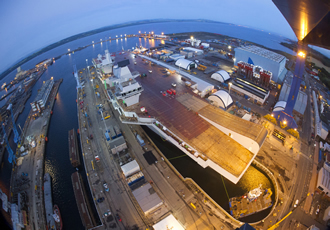Even the electrical enclosures are innovative on new aircraft carriers

Following David Cameron’s announcement that both will be taken into service with the Royal Navy, renewed excitement has gripped the engineers building Britain’s two new Queen Elizabeth-class aircraft carriers. With renewed excitement comes renewed innovation, including specially coated enclosures from Spelsberg UK.
The 280m-long carriers are the largest-ever ships built for the Royal Navy. The ships will be equipped with a variety of aircraft types including F-35B Joint Strike Fighters and helicopters. As the future flagships of the Royal Navy, every technical detail of these giant, cutting-edge warships has been carefully thought through.
Ten thousand people have been involved in their design and construction; and long-term jobs have also been secured as the vessels will need continued maintenance throughout their service life. Unsurprisingly, there are innovations – both small and large – relating to these ships and the many systems within them.
In fact, to drive all the on-board systems, each ship is capable of generating 110MW of power. This is distributed around the ship via 1.5 million metres of cable, so an enormous number of junction boxes and enclosures are required. The boxes need to be incredibly tough, withstanding the salty marine atmosphere, the rigours of naval exercises and possibly the actual heat of battle. They also have to be safe and completely predictable in the event of a fire.
It might be expected that, due to their inherent strength, metal junction boxes would be used in the multitude of electrical systems on board each carrier. However, metal units are prone to damage caused by corrosion and denting, so the Aircraft Carrier Alliance which is building these ships, has opted for polycarbonate units.
Spelsberg UK enclosures were previously specified during the first stage of the project, but now the company has been asked to supply models from its TK range – each one precisely customised for its particular duty.
Chris Lloyd, General Manager at Spelsberg UK, explains his company’s contribution to this massive national project:
“The enclosure requirements were anything but ordinary, so it was inevitable that we have developed a bespoke solution.
“Each box is internally spray-coated with a special metallic paint that inhibits EMC [electromagnetic corruption] transmissions. Then they have several coatings applied to their outer surfaces; one is anti-reflective, while another ensures that in the event of a major fire they do not melt and drip, but instead turn into a foam that continues to protect the electrical connections within it.
“Each enclosure is also CNC-machined so that it exactly meets its duty requirements and fits within the - usually tight - space allowed for it. A special lid-sealing mechanism was also developed to replace the usual steel screws, which could come undone due to the constant vibration.
“Another consideration, and one which surprised us initially, is weight saving. A junction box may only weigh a fraction of a kilogramme compared to the 65,000 tonne super carriers, but the cumulative effect of many individual weight savings contributes to significant performance gain, lowers delivery costs, improves installation times, and therefore contributes to the schedule and budget requirements.”
To see if plastic enclosures would be suitable for the project, designers working for the Aircraft Carrier Alliance approached Spelsberg UK to recommend the best products for the job. Spelsberg UK is the largest supplier of non-metallic enclosures ex-stock in the UK and offers complete customisation and assembly on nearly all of its products. It was able to recommend its polycarbonate IP65 TK enclosure for the project. By supplying the enclosures fully assembled (including terminals), Spelsberg was able to help the shipbuilder greatly reduce on-site installation time.
The two carriers, HMS Queen Elizabeth and HMS Prince of Wales, are far from conventional designs. For instance, instead of the usual single control tower to the side of the flight deck, it has two control islands. In normal times the forward island controls the ship’s navigation and the rear controls aircraft movements. However, they can swap roles, or perform both roles simultaneously, should the situation demand. This gives the carrier a far higher than usual level of redundancy; meaning it can continue operations even if badly damaged.
The flight control island is closely linked to the ship’s operations room, navigation bridge, flight deck and hangar operations centre; has a groundbreaking 300⁰ field of view through some of the world’s toughest glass; and equipped with a state-of-the-art flying control solution, similar to that used at RNAS Yeovilton and at the RAF airfield that was established in Camp Bastion, Afghanistan.
Spelsberg UK is a specialist supplier of non-metallic enclosures with a range of designs that covers most application requirements. It offers an in-house CNC and assembly service to all of its customers – helping them to specify the perfect enclosure and delivering it ready to go. In addition, its coating service allows enclosures to be treated to withstand almost any environmental challenge on the planet.
“Space for you”
Spelsberg’s company philosophy is based around the idea of providing flexibility and freedom to its customers. The space provided within each junction box; the large distribution and warehousing space; and the freedom to customise almost any product, irrespective of quantity, all equates to “Space for you”.
Similar articles
More from Spelsberg els
- Electrical equipment selected for new headquarters 16th April 2019
- Fire protection enclosures contribute to safety 3rd April 2019
- Innovative IBT system chosen for London residential project 19th December 2018
- Act now to prevent frozen and burst pipes 17th December 2018












Write a comment
No comments